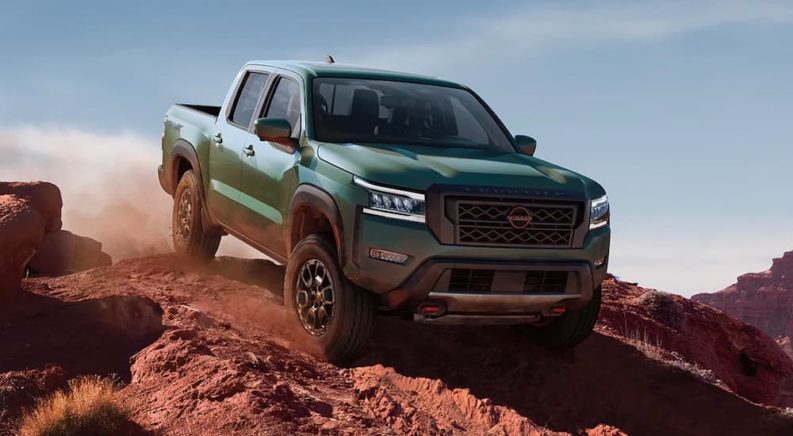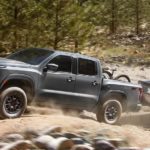The first major update for the Nissan Frontier since 2005 — the year YouTube was officially launched — includes perhaps the coolest feature of all with its “Zero Gravity” seating. The seats come bolted down from the factory, so no worries about watching one float away when you step out to get fuel. Seriously though, most of us find ourselves gobsmacked pretty much on a daily basis when it comes to breaking news on technological advances in virtually all aspects of life. When it comes to evaluating Nissan’s latest midsize pickup version against segment leaders, such as stacking the 2022 Nissan Frontier vs 2022 Chevy Colorado, the Frontier has some potential to close the gap. New features, such as a high-tech commitment to improving the overall Frontier driving experience by adding Zero Gravity seat technology (to select models in their lineup; the Nissan Titan added them in 2020), definitely give Nissan a leg-up selling point to flaunt here as well. Let’s take a look at how the Zero Gravity tech came to be.
You Can Thank Space Exploration
It’s actually a bit stunning to look at the long list of innovations that are directly related to technology developed by the National Aeronautics and Space Administration (NASA). Here are just a few breakthroughs attributed to the brilliant folks at NASA:
- Memory Foam – developed for aircraft seats and now used in many applications, including mattresses.
- Car Tires – Goodyear developed a sturdy new tire material for NASA parachute shrouds utilized on the Viking after landing on Mars.
- Baby Formula – microalgae developed for space travel is now used in more than 90% of infant formulas sold in the U.S.
- GPS – NASA’s Jet Propulsion Laboratory helped develop the network of satellites needed for GPS.
- Safer Highways – the Langley Research Center created a special grooving technique to prevent ponding on runways that is now found on many highways.
- Home Insulation – a common aluminized polyester called Radiant Barrier was originally created to thwart extreme freezing temps in space.
As you can see, this partial list of NASA-linked attributes has made life better for billions over the past few decades. Now let’s take a look at how the science of zero gravity influenced the Nissan design.
G-Force
Before we talk about the design elements, let’s explore some behind-the-scenes science. Total weightlessness is, of course, experienced in zero gravity. The mass of planet Earth has a gravitational pull of 1G, which keeps us firmly planted on the surface. However, when intense acceleration is experienced, this directly influences the amount of g-force you feel. The driver of an NHRA Top-Fuel Dragster will experience around 4G’s on his or her way to 330 mph in less than 4 seconds. A fighter pilot will endure 9G’s and sometimes even more when dogfighting or dodging missiles. By monitoring g-force changes, driving tendencies such as harsh braking and unnecessary acceleration can be recorded. The objective with Nissan’s Zero Gravity seat was to help reduce the driver’s exposure to these forces, which eventually cause fatigue and poor posture.
A Decade in the Making
Actually seeing the Zero Gravity seat technology come to fruition was a decade-long tussle with science and engineering at the forefront. The fundamental changes that Nissan sought were extreme comfort in driver and passenger seating — particularly for longer commutes. We all know the feeling of having to move around and shift our bodies as we tire from sitting in one position for too long. When we embark on a multi-hour journey, it’s inevitable our body will begin to experience the effects of being behind the wheel with limited movement in traditional seats. Our bodies will eventually yearn to slump forward to ease the burden on the lower back (and other muscles) that have become fatigued and to mollify spinal compression. Nissan aimed to improve posture and circulation as the driver experiences the effects of elongated exposure to roads and driving conditions.
Neutral Body Posture (NBP)
When NASA first set out on exploring that which is beyond, the emphasis was on safety more than comfort. This eventually prompted the uber-smart engineers (once assets were allocated) to focus more on keeping human subjects from bouncing around in a microgravity environment and feeling the associated effects. The weightless aspect of NBP intrinsically represents the natural posture of the body without the influence of muscle movement or gravity. The replication of this premise in everyday applications, such as in jetliners and automotive applications, falls in the ingenious category — with Nissan thinking outside common parameters while operating in a customer-centric mindset.
Meeting Customer Expectations
The science and engineering minds at Nissan deserve a big high-five for moving forward with this innovative concept. In 2005, the engineers at Nissan decided to make use of NASA’s groundbreaking NBP advances. Although mostly ignored by industries that could ultimately benefit from NBP-related technology, Nissan used it as a quasi-blueprint for the development of the Zero Gravity seat.
“Typical customer demand for seats is comfort, especially fatigue-free. This was the motivation for the development,” explains Akinari Hirao, the manager of the vehicle component engineering development division at Nissan. “We hypothesized that a neutral body posture, as measured by NASA in microgravity, seems to be a comfortable posture, and we validated it by our experiments,” says Hirao.
In the Lab
Keio University is Japan’s oldest educational institution, dating back to the mid-1800s. Keio’s Yamazaki Laboratory was the site of Nissan’s ergonomic experimentation, which began in 2006. The desired benefits from using NBP would lead to “a natural position where the least amount of stress is placed on our bones and joints, so we’re less likely to become tired,” as described by Nissan. “Before Zero Gravity Seats were put into production, the seat concept went through extensive testing using a driving simulator, real-world long-distance, and overnight evaluations, as well as biomechanical analysis. Testers included men and women of different heights and body types. Even medical tests were taken — like blood samples measuring lactic acidity levels — to confirm a reduction in muscular strain and fatigue.”
The emphasis was on designing the seats with 14 distributed pressure points, which aid in keeping the spine in a natural position for occupants. The unique configuration of these seats optimized support from the upper glutes to the lower neck and shoulder area. The Zero Gravity ergonomic seat structure maximizes circulation — particularly in the lower extremities — which over longer journeys directly leads to a reduction in stress.
The first discernible results from testing started to materialize in 2006. By 2007, a new two-section design connected by a flexible joint set the foundation for what would eventually become the Zero Gravity series: “Our seat has no additional mechanical structures compared with a conventional seat. We made it through optimizations of the seat surface shape and deformation properties of the backrest,” explains Hirao. “It provides proper continuous support from the pelvis to the thorax. And, it keeps the spine shape naturally in the sitting posture.”
Finally, the Seat is a Reality
Although Nissan was definitely on to something, it didn’t happen overnight. In fact, roughly six years passed before the seats were ready for their production debut. The 2013 Nissan Altima was the first automotive application anywhere in the world to utilize NBP technology. Hirao sang the praises of NASA’s development of NBP. “In my personal opinion, it is very important that the valuable research results from government projects are open to the public. The new seat brings comfort and less fatigue to the occupants in vehicles.”
After reading all of this, when you open the door of the 2022 Frontier, you may be expecting to find some far-out design that resembles more of a gamer’s ergonomic chair than a car seat. However, that’s not the case. From a visual standpoint, the technically advanced Zero Gravity seats generally resemble almost any other modern automotive product. However, after an extended test drive — to borrow a slogan from the purveyor of tasty pasta sauces — you’ll know “It’s in There!” Needless to say, it seems a good bet that other automakers like Chevy will be releasing their own versions sooner than later to let their trucks keep up with the competition.






